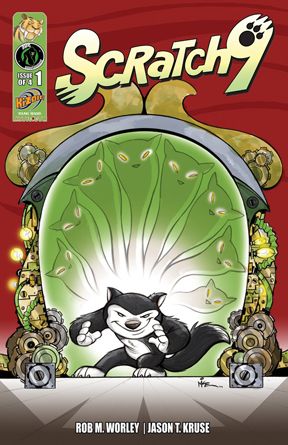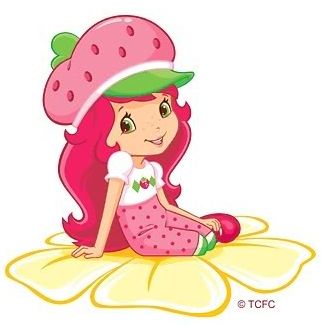I did a lot of opinionating about whether all-ages comics are likely to do well in comics stores a while back, but Jason Burns, editor in chief of Ape Entertainment, knows a lot more about it than I do—Ape publishes a whole line of kids' comics, including the creator-owned Scratch 9 and their own Little Green Men as well as licensed properties like Shrek and Penguins of Madagascar—and they announced at NYCC that they have just picked up the licenses for Richie Rich and Strawberry Shortcake comics as well. So I asked Jason if he would mind talking a bit about how they fare in the direct market, and he graciously acceded.
Brigid: Why did you choose to sell comics in the direct market, and how is that working out for you?
Jason: As a comic publisher, we can never truly walk away from the direct market. While we’re trying to run a business, we’re also fans of comics, and more importantly, the industry in general. If we don’t support it, they won’t support us. Yes, all-ages comics do not sell as well in the direct market, but it’s important for us to never lose sight of what we are, which is first and foremost, a comic publisher. We have been finding great success in both the book market and the digital market with our all-ages titles, so we will continue to explore new outlets for getting the product to consumers, but we’ll never walk away from the direct market… not while we’re still publishing comics.
Brigid: In my earlier post, I pointed out that "most comics-shop customers aren't kids, and most kids don't go near a comics shop." How does the comic shop audience mesh with your comics? Who do you think is buying Ape comics—children, parents, or adults who are reading them themselves?
Jason: In terms of our all-ages product, we’re moving the majority of it in the book market. That being said, we had some success with titles like Shrek and Penguins of Madagascar in the direct market. The beauty of those DreamWorks Animation properties is that they truly are ALL-AGES. Some kids titles get stuck with that label, but titles like Kung-Fu Panda and Megamind can (and are) enjoyed by everyone from eight to eighty, which make them more accessible than something that only targets toddlers or tweeners. That being said, after watching the reaction at the recent NY Comic Con, we feel like the majority of our purchases are coming from parents, who are then sharing the comics with their kids, which is the best way to get new readers into the industry.
Brigid: Given that many towns don't have a comics shop at all, are you concerned that you are missing out on potential readers, simply because they never go into the store?
Jason: Not really. Now more than ever it’s easier for readers find material. Whether they come direct to us, go to Amazon, stop by their local Borders, or download a digital version of our comics through iVerse, the product is accessible. The biggest hurdle for a small publisher like Ape is spreading the word prior to the release of a title. Marketing and buzz are the keys to a successful comic.
Brigid: What advantages does the direct market offer to a small publisher like yourself that would help counter that?
Jason: We see shop owners as partners. If we scratch their backs, they’ll scratch ours, and in the end, we all benefit. Right now we’re in the process of working on a number of programs that will give comic shop owners more incentives to carry more Ape Entertainment product on their shelves, and then counter that with marketing so that they know that they can then actually sell those books. The way we see it, we need to help them just as much as they need to help us, because they need to feel confident that they can sell the product to their customers.
Brigid: Is it difficult to get retailers to carry children's comics?
Jason: Yes, but it’s understandable. When it comes to the comic shops, there isn’t a lot of kid traffic coming through the doors, so they aren’t going to sell as many copies of an all-ages title as they are an edgy title. We get that. The good thing is, events like FCBD are slowly changing the way people look at comics, and because that’s such a kid heavy day, we see interest in all-ages titles increase a little more each year.
Brigid: What other venues carry your comics—newsstands, mass market stores, bookstores?
Jason: Bookstores, mostly, especially in terms of the licensed material. We’ve also had a lot of success recently through the digital space with titles like Pocket God, which for some time, was the number one book on all of iTunes… not even just comic, but book in general. That’s a very encouraging thing, because we’re seeing that different titles can have success in one venue, and another can have success through another venue. It’s enabling us to plan each title with the distribution audience we’re trying to target.
Brigid: What are the challenges involved in getting into those venues?
Jason: Bookstores are always hard. They work very far in advance, so we need to have the material done long before we normally would in the direct market. They also don’t support a lot of unrecognizable titles, so unless you’re rocking a licensed property or a direct market hit, you’re not going to get a lot of bookstore support. But again, we get it, they’re not going to carry product that they can’t sell, which is why we’re trying to give them product that they can.
Brigid: Why do you choose to publish single-issue comics rather than full-length graphic novels?
Jason: We actually do a little bit of both. It all depends on the title.
Brigid: Do you publish any graphic novels? If so, will you sell them through comics shops or bookstores?
Burns: We do, and ultimately, we’ll distribute them through both channels. A lot of what we’re doing in the all-ages space now are digest-sized collections of, say, our DreamWorks Animation titles, and we are selling them in both comic shops and bookstores.
Brigid: Some people feel that $3.99 (or $3.95 in your case) is too much for a children's comic, because parents won't spend that much on something they regard as disposable. What has been your experience in this regard?
Jason: It is. We wish we could charge less for a comic, but the cost that goes into creating them makes it impossible for us to do that. This is where the digest-sized collections have a much more appealing draw to parents, because we can give them more content for $5.95.
Brigid: Would using newsprint instead of glossy paper reduce the cover price? By how much?
Jason: Actually, it would probably cost more, because printers just don’t use that process as much anymore. We recently looked into it for a special book we’re producing, and we were quoted more than it would cost us to print our standard gloss.
Brigid: How is the digital piece working out for you? Is it an appreciable percentage of your sales?
Jason: Yes, especially with certain titles. Some titles do great digitally, and others do better in print. It’s interesting to see the differences in the audience, but the digital space is definitely growing, and we’re seeing it build month after month.
Brigid: Given all the challenges children's comics face, especially in the direct market, why do you choose to publish them?
Jason: They have been great to us. Yes, we would love for sales to be better in the direct market, but our sales have been very positive in the book market and in the digital space, and it has raised the profile of our company dramatically. We will continue to do them as long as they continue to give us the same year we’ve had in 2010.
Brigid: At NYCC, you announced you would be publishing Richie Rich and Strawberry Shortcake comics. What are your plans for these in terms of format, timing, and marketing?
Jason: We haven't given a lot of details on them yet, so I have to be a bit tight lipped about them, but we’ll be doing a mixing of direct market floppies and digest-sized trades, which will circulate throughout comic shops and bookstores. We have some really fun marketing plans in place for both Richie and Strawberry as well, which we think will get both retailers and consumers excited about the titles.




